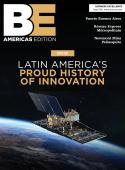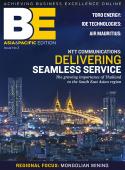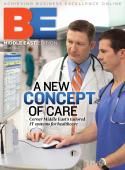A┬áhub for the hubs┬áThe Rogue Valley InternationalÔÇôMedford Airport in Southern Oregon, which serves the city of Medford, Jackson County, and the entire Rogue Valley in addition to seven other counties, has just completed the biggest upgrade in its history, as John OÔÇÖHanlon learns. The Rogue Valley InternationalÔÇôMedford Airport (MFR) is designated as a non-hub facility, but it services eight hub cities with nonstop flights to Seattle, Portland, San Francisco, Los Angeles, Las Vegas, Phoenix, Salt Lake City, and Denver. The airport handled about 650,000 passengers in 2008, three times the population of Jackson County where it is located, and passenger trade is its main business, though it also serves a freight function for local business and can take the largest aircraft short of the A380 Superjumbo, says airport director Bern Case. ÔÇ£In 1999 we extended the main runway from 6,700 feet to 8,800 feet. We have had Air Force One in here, which is a 747, and a couple of weeks ago we had a 747 of the National Guard.ÔÇØ Perhaps the biggest airplane to land and take off at Medford is the Ukraine-built Antonov freighter, which calls from time to time to carry helicopters from the local depot of Erickson Air-Crane.An airport of this importanceÔÇöand potential, since it is so strategically placedÔÇödeserves more up-to-date facilities than were available at the existing terminal, built in 1949. In addition, the control tower was no longer really fit for the purpose, because parts of the airfield couldnÔÇÖt be seen clearly from it. Accordingly, in March 2006 work commenced on a new $35 million terminal building and, adjacent but free-standing, a higher control tower costing a further $3 million. The general contract was given to a local firm, Adroit Construction of Ashland, Oregon.Having completed the building work on schedule and on budget, operations started in the new building in January this year. All that remains now is to demolish the old terminal and the tower that sits on top of it and pave the area so it can be used for aircraft parking.Although the new 100,000-square-foot facility is three times the size of the old one, it doesnÔÇÖt feel too big, says Case. ÔÇ£We have room for growth now, but we were so jammed in before that weÔÇÖre really enjoying having enough space and the knowledge that we have enough infrastructure to support future expansion for 20 years at least.ÔÇØPrior consultation with all the stakeholders, including the local community, threw up three key requirements, the first of which was that they wanted better observation facilities. ÔÇ£WeÔÇÖve built a tremendous observation deck, and you donÔÇÖt have to be a passenger to go there. ItÔÇÖs secure, you can go and have lunch, and you can watch aircraft land and take off to your heartÔÇÖs content. ItÔÇÖs been a tremendous hit,ÔÇØ Case says.The second requirement was a bit more practical: they wanted more bathrooms. Now there are six sets, containing both menÔÇÖs and womenÔÇÖs facilities, and if one is closed for maintenance or cleaning, there are plenty of alternatives.The third thing on the publicÔÇÖs wish list was a decent restaurant. The former snack bar was inadequate, but the budget didnÔÇÖt really allow for full-scale restaurant facilities in both the non-secure and the airside parts of the building. Medford came up with a solution so innovative that when Case presented it at the National Airports Conference last year, it attracted the attention of a good number of similar-sized airports, many of which are looking at following the same model. The kitchen sits between the secure and non-secure areas, so it can serve both sides through what is called a ÔÇ£one-way sally port.ÔÇØ ÔÇ£It meets all the security requirements,ÔÇØ says Case. ÔÇ£Food can go out through what I call a one-way Lazy Susan, but nothing can go back in. By doing that weÔÇÖve gained two restaurants for the overhead of one.ÔÇØ The new restaurant at once gives travelers the ability to have a decent meal in transit and gives the general public somewhere they can come to enjoy a meal out. It will create an important revenue stream for the airport, doubling the annual catering income to around $200,000 and attract more traffic, at the same time satisfying the very stringent demands of the Transportation Security Administration.The terminal building was built to LEED standards, though the County decided it didnÔÇÖt need to pay the considerable fees for a formal certificate. Case summarizes the principal features: ÔÇ£WeÔÇÖve used high-efficiency HVAC and incorporated a lot of skylights so we donÔÇÖt need a lot of lighting during the daytime. We have tinted windows to keep it cool in sunny weather. They look good, too.ÔÇØ┬á By using the terrain, an important power saving was achieved in the simplest way. You walk into the terminal from the parking lot at ground level, but when you get to the other side where the air bridges are, youÔÇÖre at the right height for boarding. ÔÇ£That way we avoided escalators, which are really not very green; theyÔÇÖre big expensive pieces of equipment and often cause accidents, so we feel good about cutting them out.ÔÇØ And the parking lot itself is slightly canted to get surface water to run off naturally instead of being drained through underground pipes. That saved not just on the construction cost but potentially on maintenance too.Perhaps the most exciting innovation at MFR hasnÔÇÖt even been started yet. Airports take up a lot of land but donÔÇÖt use much of itÔÇöthere are many reasons why you canÔÇÖt have people or any installations more than a few feet high anywhere near the runways. But you can use a lot of this spare land for solar arrays to generate power, which can then be sold to the grid at a profit. ItÔÇÖs been done before, notably at Fresno Yosemite and Denver International Airports, and at Medford over 70 acres have been designated for a new solar park to be built by a local firm, RHT Energy Solutions, and funded under the provisions of the $787 billion stimulus package for sustainable projects. ÔÇ£WeÔÇÖre waiting for the grant money to be approved, and then we can go ahead at full speed,ÔÇØ says Case. Solar arrays in the parking area will provide power to the airport itself, and a further 47-acre standalone array will supply around 8 megawatts of energy that will be sold, raising $1 million annually.Having spent 15 years at Medford, half of his entire working life in the industry, Case is not planning on moving before retirement in five yearsÔÇÖ time. By then he is convinced the airport will be generating substantial revenues from its solar power interests and growing commercial connections, and will be serving the local community better than ever. ÔÇô Editorial research by Sam Howard┬á









